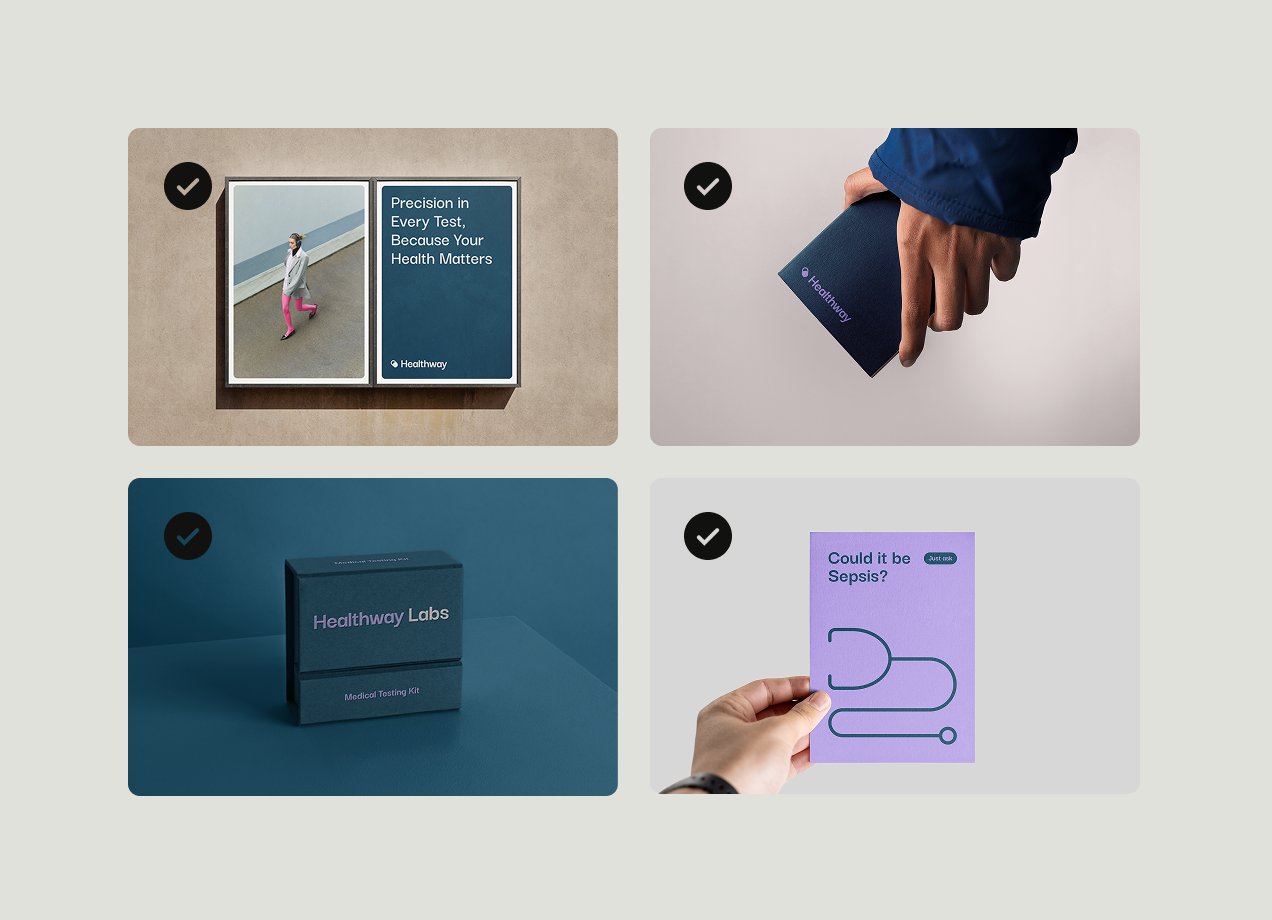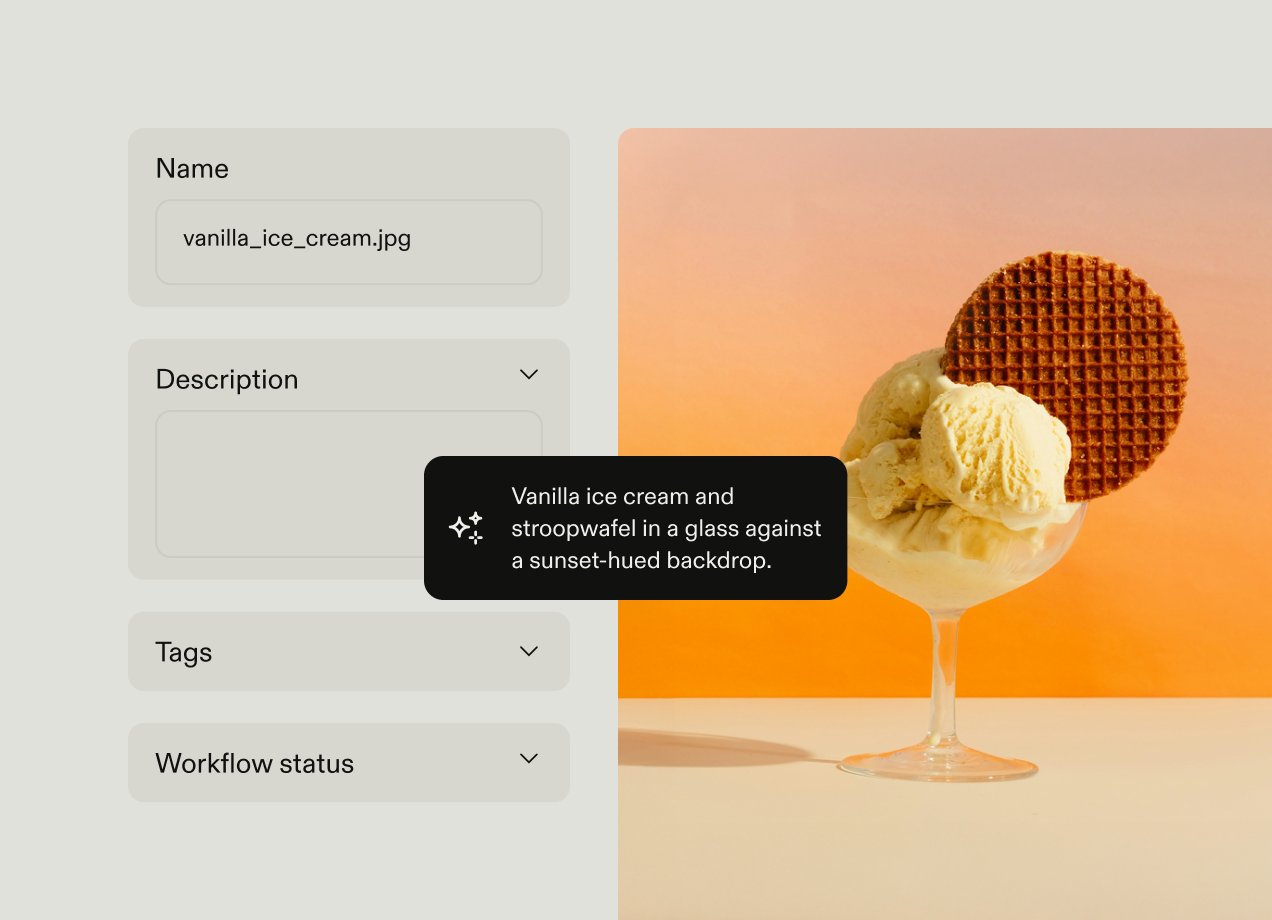Not long ago, managing brand assets meant a mess of shared drives, Dropbox links, and email attachments. Every team had its own “system,” and finding the right file felt like a treasure hunt.
Today’s brands can’t afford that kind of chaos, when speed, consistency, and control are everything. The modern asset library changes all that. These organized, searchable hubs do more than store files; they connect people, processes, and brand content in one place.
This article explores how modern asset libraries solve everyday pain points and improve marketing efforts, and how platforms like Frontify are redefining what brand management can be.
What is an asset library?
An asset library is a digital repository where you can store, organize, and manage brand assets with structured metadata, collaboration features, and governance controls.
While basic file storage systems simply house files in folders, asset libraries are for managing the entire lifecycle of a brand and its creative assets.
Asset libraries are dynamic, searchable hubs that support brand consistency and productivity. When teams can quickly find and use the right, up-to-date assets, they avoid duplication, reduce errors, and keep every piece of content on brand at every touchpoint. These efforts help you save time and protect brand integrity at scale.

How asset libraries transform digital content management
Modern asset libraries solve common business problems and deliver valuable benefits, including:
- Intelligent discovery. Instead of relying on file names or folder structures, you tag assets with metadata that captures details like usage rights, campaign, format, and product line. AI-powered search analyzes this metadata — along with visual and contextual cues — to surface the most relevant version instantly. For example, a marketer searching for a holiday banner can find the approved design from last year’s campaign in seconds, even if the file name is “Q4_final_v7.psd.”
- Streamlined collaboration. Asset libraries with streamlined collaboration functions bring structure to creative workflows. Built-in approvals and comments keep feedback tied directly to each asset, so designers, marketers, and approvers can resolve revisions in one place. Permissions limit who can edit or publish, preventing off-brand changes while keeping projects moving.
- Foundational governance. Modern asset libraries provide the groundwork for brand control, so your teams only use approved, high-quality assets across campaigns. But proper end-to-end brand governance, including compliance tracking and automated workflows, emerges when those libraries operate within a full DAM.

Asset library vs. digital asset management (DAM)
A digital asset library is the foundation of a digital asset management (DAM) system. On its own, a library provides easy discovery, collaboration, and foundational governance. Without additional layers of workflow automation, analytics, and compliance that a DAM provides, assets may just be stored, not strategically managed.
A DAM builds on the asset library by connecting storage to strategy. For example, Frontify’s DAM combines centralized asset libraries with live brand guidelines, on-brand templates, and advanced, built-in governance.
A DAM with an asset library as its foundation is a governance-first platform that stores assets and keeps every touchpoint aligned, consistent, and measurable.
Asset library use cases
Asset libraries support a wide range of teams to solve everyday challenges and improve efficiency.
- Marketing and creative teams: Asset libraries are a hub for all marketing campaigns and brand materials, so no one has to dig through shared drives or Slack threads to find what’s current. Designers and marketers can self-serve assets instead of waiting on creative ops or brand managers, freeing up time and reducing review cycles.
- Sales and business development: Asset libraries give sales teams instant access to the most current collateral, proposals, and presentations. Plus, when you connect your asset library to a CRM platform, reps can easily access approved assets directly from a system they already use to avoid tool-switching.
- HR and internal communications: HR teams use asset libraries to manage materials tied to employer branding, including recruitment campaigns, onboarding packets, internal newsletters, training documents, and culture initiatives. Libraries also store pre-approved templates (for job postings, internal emails, intranet updates, etc.) to allow HR and internal comms teams to move fast without relying on design or brand teams.
Essential asset library features & how AI is driving them
Today’s most advanced asset libraries are more than organized repositories — they’re intelligent systems. Artificial intelligence now drives everything from automated tagging and smart search to compliance checks and predictive insights. With these capabilities, your library becomes a hub of discoverability, governance, and performance.

Advanced search and discovery capabilities
When users can easily find approved, up-to-date assets, they’re less likely to reuse outdated logos or off-brand visuals. Advanced search functions reduce the time your teams spend hunting through folders and drives. Remember: if assets aren’t discoverable, they’re effectively lost.
AI is central to these search and discovery features, using capabilities like:
- Natural language search: Natural language processing (NLP) interprets user intent rather than just keyword matches. Instead of typing exact tags like “2023 campaign hero banner”, users can type “show me the latest summer campaign images,” and the system understands “latest” as a date filter, “summer campaign” as a tag or folder, and “images” as a file type.
- Visual similarity matching: Modern asset libraries use AI to identify images or videos that resemble a reference asset. This feature helps creatives find alternate visuals without manually browsing folders.
- AI-powered content recognition: This AI-powered feature helps you find files based on objects, colors, or layout rather than using metadata alone. It allows your library to recognize related assets even if they’re not tagged identically or named similarly. For example, it can detect “person,” “outdoors,” and “logo visible” in an image and assign these as tags without human input.
- Saved search functionality: Save complex or frequently used search queries (e.g., “social assets, Q4, approved”) and return to them later with one click, enabling repeatable workflows.
- Predictive search suggestions: A search bar that autocompletes terms or suggests queries as users type, based on specific criteria or patterns, helps users find the right asset faster, even if they don’t know the exact name.
- Optical character recognition (OCR): OCR allows users to search for text within images, PDFs, and scans. For example, an asset library with OCR capabilities could find an ad with the phrase “Just Do It” even if the words are embedded in the image.
Robust metadata and taxonomy management
Proper metadata structure supports advanced reporting and usage analytics. And AI makes it more automated than ever, with less manual work needed from your team.
AI can analyze different types of assets, from static documents to media assets like images and videos. Using AI, your library will generate tags and metadata automatically, identify duplicates or near-duplicates, and suggest or auto-fill asset titles and descriptions based on content recognition.
- Custom metadata fields: Define and configure custom metadata fields — beyond default ones like “name” or “date” — so your asset library reflects how your company actually operates. For example, admins can create fields like campaign name, product category, usage rights, tone, region, audience, and license expiration.
- Controlled vocabulary systems: These systems are standardized, pre-approved sets of terms (or taxonomy) that users must choose from when tagging assets. Instead of free typing, users pick from a defined list (e.g., “Photography Type: lifestyle/product/editorial”). Controlled vocabularies eliminate duplicate or near-duplicate names, since users have to choose from a pre-determined list of tags.
- Automated tagging workflows: When a new file is uploaded, the system analyzes its contents (visuals, text, or metadata) and applies tags, eliminating the need for manual tagging. For example, it can detect a person, product, logo, or color palette.
- Bulk editing capabilities: Users can apply metadata changes to multiple assets at once by selecting a set of files and updating certain attributes in one action, like license expiration date, product category, or usage region.
- Metadata inheritance: To reduce repetitive and manual tagging, metadata will automatically “flow down” from a parent folder, collection, or template to all child assets within it. For example, if a campaign folder is tagged “Spring 2025” and “Global,” all assets in that folder will inherit the same tags. Inheritance can be automatic or selectively overridden when needed.
- Integration with existing taxonomies: To prevent data silos and keep metadata consistent, your DAM or asset library can connect to your CMS, CRM, or other product databases and automatically pull in or update metadata, including product IDs, SKUs, campaign codes, or department names.
Collaborative tools and workflow automation
In modern asset libraries, AI can monitor uploads and flag off-brand or outdated assets automatically. When assets enter workflows, AI validates their compliance with brand rules before approval or publishing. Plus, AI-driven alerts can notify reviewers when compliance issues arise, streamlining approvals and reducing risk.
- Approval workflow builders: Define the stages of your workflow (e.g., designer upload → brand review → legal approval → publish) and assign reviewers or departments to each step. Systems with this kind of function can automatically route assets through the sequence.
- Stakeholder notification systems: Automated notifications are triggered when an asset moves stages, when someone adds a comment, or when deadlines are near. Delivery methods include email, in-app alerts, or integrations through platforms like Slack or Microsoft Teams.
- Real-time collaboration features: Multiple users can view, edit, or annotate assets simultaneously. Users can open an asset and make comments or adjustments in real time, often with presence indicators (showing who’s online).
- Commenting systems: Team members can pin comments to specific parts of an asset (like one particular frame of a video or a specific element in a template).
- Version comparison tools: Modern asset libraries and DAMs have a feature that displays the differences between asset versions, either side-by-side or overlaid. Users can visually compare two iterations of an image, layout, or video to spot changes (e.g., swapped text, color adjustments, design tweaks).
- Automated status updates: When a reviewer approves an asset or when a license expires, the system automatically updates the status on that asset and can trigger notifications or access restrictions.
- Deadline management: Each task or workflow stage can have a deadline for which reminders and escalations trigger automatically when dates approach or are missed.
Security and access management
To keep your asset library secure, AI can detect unusual access patterns (e.g., large downloads from unusual accounts) and trigger alerts. It can also detect expired or region-restricted assets automatically and restrict access proactively.
- Role-based permissions: Admins assign roles, such as viewer, editor, approver, or admin. Each role has predefined access rights. Permissions can be granular (down to specific folders, asset types, or metadata fields).
- Secure sharing options: Users can generate expiring or password-protected links, restrict downloads, or apply watermarking to previews. Some systems also allow view-only access for clients or vendors.
- Audit trails: Every interaction (view, edit, comment, approval, deletion) is timestamped and recorded in an activity log, ensuring transparency and accountability. The log records who accessed, modified, downloaded, or shared assets (and when).
- Integration with authentication systems: Employees log in to the asset library and DAM using corporate credentials for existing identity and access management (IAM) systems like SSO (Single Sign-On), SAML, OAuth, Okta, Azure AD, or Google Workspace.
- Guest access controls: Admins can create guest profiles with limited permissions, time-based access, or project-specific visibility.
- Rights management features: Define when, where, and how an asset can be used (e.g., “usable until March 2027”). The system can automatically hide, watermark, or turn off downloads for expired or restricted files.
Integration and extensibility
Automatic integrations make it easier for teams to work without constantly switching platforms.
- API capabilities: APIs (Application Programming Interfaces) allow developers or connected tools to programmatically access, manage, or exchange assets and metadata. Using REST or GraphQL endpoints enables the library to retrieve approved assets for use in another platform, update metadata automatically, or sync asset usage stats back into reporting tools.
- Creative tool integrations: Use native or prebuilt integrations to connect your asset library or DAM to tools like Adobe, Figma, Sketch, or Canva. Designers (and even nondesigners) can open, edit, and re-upload assets directly from creative workspaces without leaving the design tool.
- Marketing automation integrations: Connect with platforms like HubSpot, Marketo, or Salesforce so users can automatically pull approved visuals, videos, or copy from the asset library into campaign builders and email templates.
- CMS connectivity: Integrate your asset library with platforms like WordPress, Sitecore, or Contentful. Editors can browse and insert assets from the library directly into web pages, blog posts, or landing pages.
- Custom development options: Modern asset libraries and DAM systems allow developers to build extensions, connectors, or workflows tailored to the organization’s specific needs. They use SDKs, webhooks, and developer sandboxes for creating bespoke automations. For example, auto-tagging assets via an AI service, generating image renditions for specific channels, or connecting to proprietary databases.
How to implement asset library solutions
From strategic planning and clean migration to user training and adoption, each step below helps you build a system that people will rely on every day.
1. Plan your asset library strategy
First, gather input from all stakeholders. This includes members from marketing, design, sales, HR, IT, and anyone else who is heavily involved in the maintenance or usage of your asset library. Have them identify the challenges they currently face and what success would look like, so your asset library is as useful to them as possible.
Based on stakeholder input, determine what success will look like. Common performance KPIs for asset libraries include asset reuse rate, time to find assets, number of duplicate uploads, or adoption rate by department. Track these metrics before and after implementation to best understand usage and how you can improve the user experience.
2. Organize and migrate your assets
Audit your current assets to identify what’s current, redundant, or outdated. Decide what to migrate and what to retire. You’ll likely need input from your stakeholders to determine what assets are essential and which ones they don’t use anymore.
Then, create the categories, tags, and metadata fields you’ll use to make assets easy to find. This step includes establishing uniform naming conventions, descriptive tags, usage rights, and version details.
Taxonomy brings order to metadata by structuring how assets are categorized and connected. It should be broad enough to cover all asset types but intuitive enough for users to navigate without training. Implementation usually involves defining clear hierarchies (e.g., campaign → region → format) and controlled vocabularies to prevent drift.
During or after migration, use system-level duplicate detection to flag redundant files. Modern platforms can identify duplicates even when filenames differ, using content recognition or visual similarity detection.
Perform a quality check: review search results for key asset types, test metadata filters, confirm rights and expiration dates, and spot-check uploads for accuracy.
Before a full rollout, test the system with a small group of representative users from different teams. Feedback can reveal usability issues, missing metadata, or unclear permissions.
3. Offer training to encourage user adoption
Create a phased rollout plan to reduce disruption. Start with high-impact teams or core asset types, then expand in waves. Build in checkpoints to assess adoption, update training materials, and adjust metadata structures based on real-world use.
Effective adoption depends as much on change management as on technology. A clear communication plan helps frame the asset library as an enabler, not another layer of admin.
Consider tailoring your training to specific user needs rather than offering a one-size-fits-all tutorial. For example, designers might focus on uploading and version control, while marketers and sales folks focus on search and sharing.
Even after rollout, maintain a visible support structure. Use FAQs, office hours, internal champions, or a dedicated channel for questions. Involve peer champions from early pilot teams to help bridge the gap between IT administrators and end users.
Why Frontify is more than an asset library
An asset library isn’t a set-and-forget tool. It needs active curation and engagement to stay valuable.
Frontify delivers that evolution by transforming asset libraries into connected, governed, and easy-to-adopt brand environments built for enterprise scale. Its AI-powered and automated capabilities make your asset library faster and smarter, helping your teams surface the right assets instantly and keep metadata up to date with minimal effort.
Here’s how:
- Unified brand hub. Frontify combines asset libraries with guidelines, templates, and workflows, creating one connected environment where teams find and use assets in the right context. AI-driven content search and tagging enhance that connectivity, letting teams discover assets based on real content, not just filenames or manual metadata.
- Governance-first philosophy. Frontify ensures assets are not only stored but actively governed through metadata, permissions, compliance checks, and integrations that keep brands protected.
- Ease of adoption. Intuitive UX and role-based access drive adoption across all users, from creatives to sales to HR, making brand governance a shared responsibility, not a bottleneck. Features like the AI-powered Brand Assistant make it easy for every user to find answers, follow guidelines, and stay on brand without added oversight.
- Enterprise-ready impact. Scalability and security make the platform fit for enterprise complexity. As seen with Kia’s rebrand, Frontify empowers global organizations to manage transformation at scale by aligning teams, assets, and workflows across every region.


